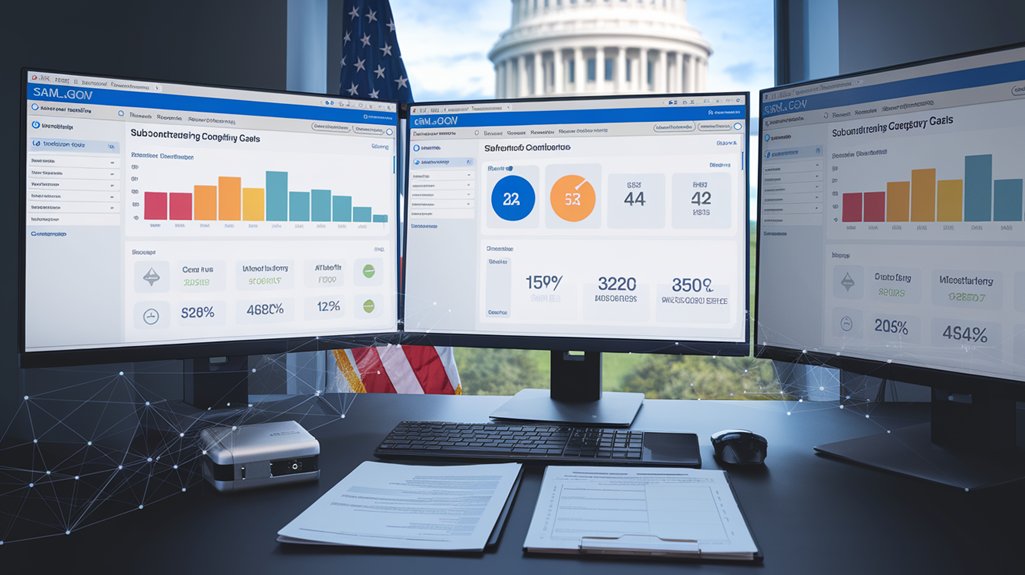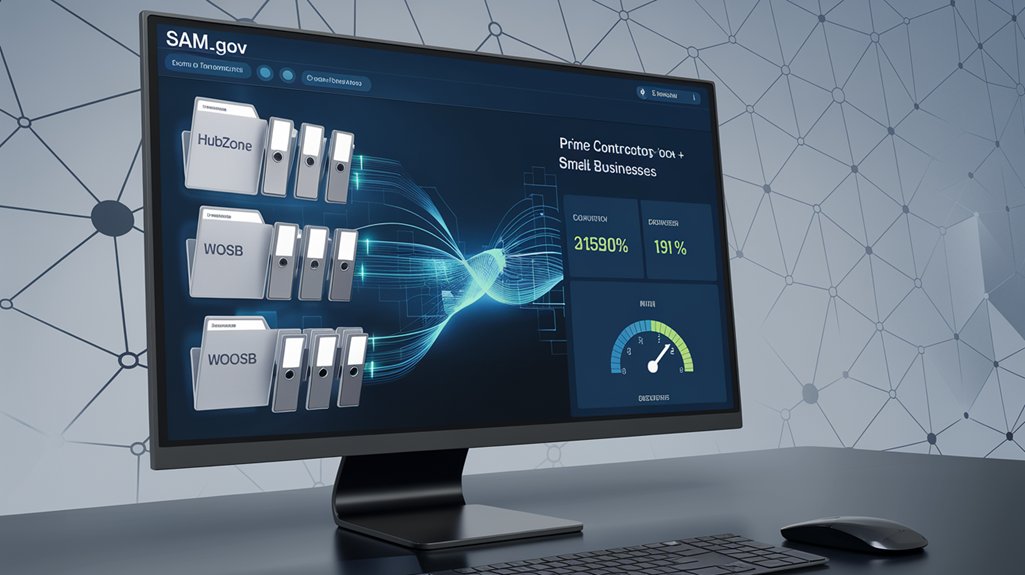SAM.gov streamlines federal subcontracting through its integrated platform for registration, opportunity search, and compliance reporting. The system centralizes subcontractor identification via Dynamic Small Business Search tools, allowing prime contractors to filter by socioeconomic categories. Contractors managing subcontracting plans can automate FAR 52.219-9 reporting requirements and monitor small business utilization goals directly through the platform. Regular profile updates enhance visibility and partnership opportunities for businesses seeking federal contract participation. Further exploration reveals additional efficiency-boosting features.
The Evolving Role of SAM.gov in Federal Subcontracting

SAM.gov has transformed into the backbone of federal subcontracting processes, serving as the central registration hub for entities seeking to do business with the government. The platform continues to expand its capabilities beyond basic subcontractor registration, now offering thorough contract opportunity management tools that streamline the procurement process.
As SAM.gov evolves, it consistently improves its user interface to enhance navigation for subcontractors. The system now integrates with various federal acquisition platforms, creating a unified ecosystem for subcontracting information. This integration facilitates more efficient data consolidation across government systems, providing subcontractors with a single access point for critical information. Federal grants and assistance opportunities become readily accessible through the streamlined registration process.
The platform’s enhanced reporting capabilities have become increasingly valuable for tracking subcontractor performance and ensuring compliance with federal regulations, making SAM.gov an indispensable tool in modern federal contracting. Subcontractors benefit from the platform by gaining access to potential partners while maintaining their lack of privity with government entities, allowing them to focus on specialized work under prime contractors.
Navigating Compliance Requirements for Subcontracting Plans

When contractors pursue federal opportunities, they must understand the thorough framework governing subcontracting plans to avoid compliance pitfalls. FAR Part 19 and Clause 52.219-9 establish requirements for contracts exceeding $750,000, with specific percentage goals for various small business categories.
Contractors face several compliance challenges when managing these plans:
- Maintaining accurate documentation of subcontractor outreach activities and selection processes
- Ensuring timely subcontractor payment and addressing payment issues without prohibiting communication with Contracting Officers
- Submitting required electronic reports through SAM.gov or agency systems, regardless of activity level
Federal grant opportunities can significantly boost revenue streams when properly leveraged through SAM registration. Regular plan updates and monitoring of subcontractor compliance are essential best practices. The Office of Procurement Diversity offers critical resources for identifying certified small businesses that qualify for subcontracting goals. Contractors can select from various plan types including Individual, Master, Commercial, and Comprehensive Subcontracting Plans, each suited to different contractual situations. Contractors should establish clear procedures and provide staff training on FAR 19.7 requirements to maintain compliance throughout the contract lifecycle.
Leveraging SAM.gov to Meet Small Business Subcontracting Goals

Thousands of federal prime contractors rely on effective subcontracting strategies to meet their small business participation requirements. SAM.gov serves as the primary platform for subcontractor identification, providing access to verified small business profiles and streamlining the process of finding qualified partners.
Prime contractors can use SAM.gov in conjunction with the Dynamic Small Business Search (DSBS) to filter potential subcontractors by socio-economic categories, including HUBZone, women-owned, and veteran-owned businesses. This targeted approach enhances opportunity visibility for small businesses while helping primes achieve their subcontracting goals. According to recent updates, prime contractors must now notify Contracting Officers of late payments to subcontractors within 30 days. Maintaining updated SAM profiles is crucial for small businesses seeking to attract potential prime contractor partnerships.
SAM.gov and DSBS provide powerful search tools that connect prime contractors with small businesses from diverse socio-economic categories.
The system also supports compliance by automating required reporting under FAR 52.219-9, ensuring primes accurately document their small business utilization.
Contract-specific subcontracting plans registered through SAM.gov help Contracting Officers monitor performance throughout the contract period.
Frequently Asked Questions
How Long Does SAM.Gov Registration Typically Take to Process?
SAM.gov registration timeline typically spans 2-8 weeks to complete. The standard processing takes up to three business days, but external reviews may extend this period.
Registration can require up to 10 business days to become active for certain entities. Processing delays commonly occur due to complex business structures, inaccurate information, technical issues, high registration volumes, or missing documentation.
Preparing all required documents and avoiding errors can help minimize these delays.
Can Foreign Entities Register on SAM.Gov for Subcontracting Opportunities?
Yes, foreign entities can register on SAM.gov for international subcontracting opportunities.
Foreign entity eligibility follows the same fundamental requirements as domestic companies, though additional steps are necessary. Foreign organizations must obtain both a DUNS number and an NCAGE code before registration.
They must guarantee consistent information across all systems (IRS, DUNS, NCAGE, and SAM) to avoid delays. The registration process is free of charge and provides access to federal contracting and subcontracting opportunities.
What Happens if a Subcontractor Loses Their SAM.Gov Registration?
When a subcontractor loses their SAM.gov registration, they face several serious consequences.
Primarily, they become ineligible to participate in federal subcontracting opportunities. Subcontractor responsibilities include maintaining an active registration to guarantee continuous eligibility for federal work.
Without proper registration, they may also experience payment delays, as inactive CAGE codes prevent processing of payments.
Prime contractors often avoid working with subcontractors who have lapsed registrations due to the associated compliance risks and potential project delays.
Are There Exemptions to Subcontracting Plan Requirements?
Several subcontracting exemptions exist for plan requirements based on specific criteria.
Contracts awarded on behalf of foreign governments, those performed outside the U.S., and contracts below certain dollar thresholds may be exempt.
Additionally, internally generated costs like salaries, utility expenses, depreciation, and taxes are excluded from subcontracting bases.
Small business contractors typically don’t receive exemptions as they’re often beneficiaries of these plans.
Certain agencies, such as the State Department, may have unique regulations regarding subcontracting requirements.
How Frequently Must Contractors Update Their SAM.Gov Profiles?
Contractors must update their SAM.gov profiles annually at minimum, as registrations expire exactly one year from the last update date.
Profile accuracy is critical, and any business information changes should be updated promptly rather than waiting for annual renewal. This includes modifications to contact information, capabilities, employee counts, and NAICS codes.
Many experts recommend quarterly reviews to maintain registration frequency and guarantee compliance with federal regulations, preventing potential exclusion from government contracting opportunities.